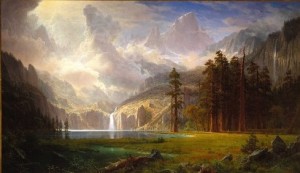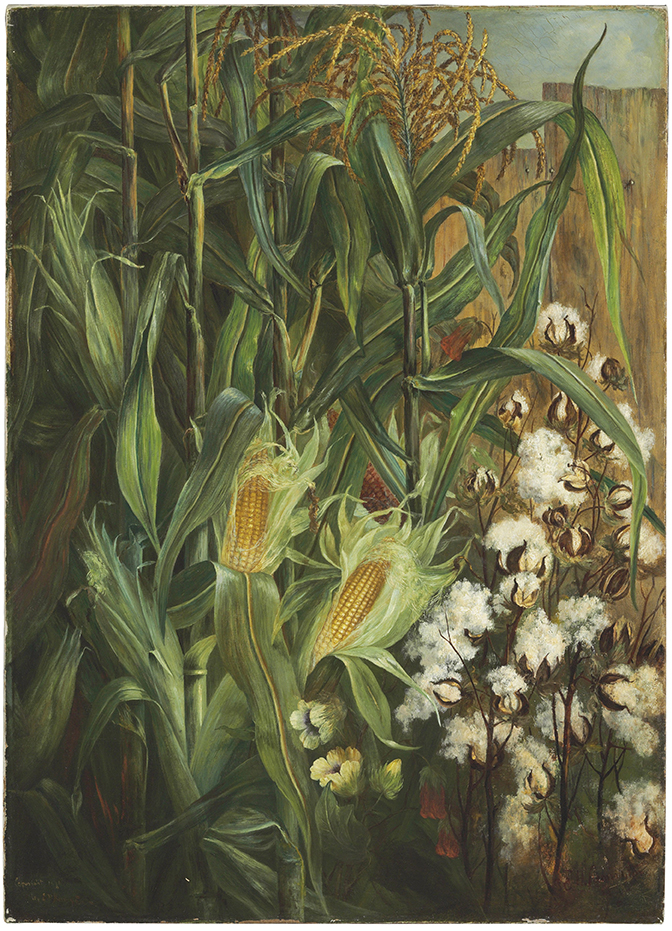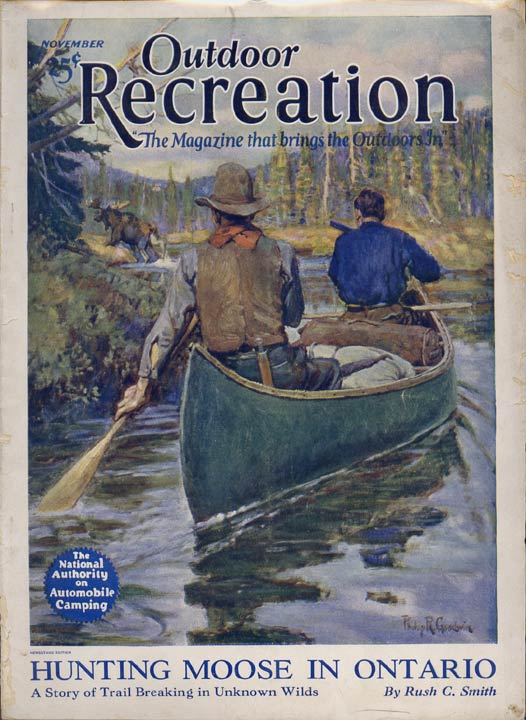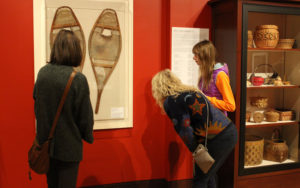

This re-imagining coincided with our recently announced status as a Smithsonian Affiliate—the only one in Upstate New York. We now have over 3,000 pieces in our collection, including great American paintings, illustrations and works on paper, Native American artifacts, artistic works from post-war America to the present day, photography, and arms and armor.
Visions of AmericaAmerican Illustrators Remington and Russell Wildlife Modern & Contemporary The Taos Society Haudenosaunee Gallery

Albert Bierstadt (1830-1902), Mount Whitney, circa 1877, oil on canvas. Rockwell Foundation Purchase. 78.14 F.
American art continued to be heavily influenced by British tastes well into the 19th century. As a young nation seeking to distinguish itself from colonial origins, the United States struggled to find an independent artistic voice separate from the mother country. The majority of wealthy Americans at this time continued to collect European rather than American art, revealing a domestic sense of cultural inferiority. Even after the founding of the National Academy of Design in 1825, many American artists who sought formal training traveled abroad in order to attend the more established academies of Europe.
By mid-century, artists had slowly begun to engage an American subject matter. Uniquely domestic themes and methodologies emerged such as the documentation of indigenous populations, the depiction of unspoiled landscapes in the virgin wilderness, the cataloguing of exotic flora and fauna, and the tracking of epic surveys which explored the continent’s seemingly endless frontier. Such subjects were indeed exotic to a curious eastern audience who craved information about the vast territorial acquisitions which had roughly tripled the size of the original colonies by 1850.

Thomas Moran, Green River, 1877. Oil on canvas. Clara S. Peck bequest. 83.46.14
The first inherently American art movement was the Hudson River School, a group of New York City-based landscape painters that pursued idealized naturalism. Active the second half of the 19th century, the Hudson River School helped to elevate the status of landscape painting to an academic level previously unknown for that genre. This school is best known for its romanticized landscapes of upstate New York – primarily the Catskills and Hudson Valley – and for epic paintings which celebrated the virgin wilderness of the new American territories. Thomas Cole is credited with being the father of the Hudson River School, which counted Albert Bierstadt, Thomas Hill, Worthington Whittredge, and Thomas Moran among its ranks. This premier American school influenced a wider circle of followers and became the initial platform upon which future American art movements would build.

Elizabeth H. Remington. The Two Kings: Corn and Cotton, 1876, oil on canvas. Clara S. Peck Fund. 2015.2.
When the historically controversial idea of manifest destiny emerged, it was harnessed to bolster support for the territorial ambitions of the young United States. This nation-centric mindset suggested that the United States was preordained to extend across the entire continent, from Atlantic to Pacific. As Anglo-European settlers moved farther and farther west throughout the 19th century, they forced the displacement of Native Americans from their ancestral lands. By the early 1850s, the United States had more than tripled its territorial holdings from colonial times and now spanned the entire continent. However, this gain was at the expense of all native cultures previously inhabiting this vast land.

Frederic Remington (1861-1909), The Bronco Buster, bronze. Rockwell Foundation Purchase. 85.57 F.
Remington defined the American West in our collective imagination perhaps more than any other artist. His illustrations of western subjects were familiar to eastern audiences, regularly appearing in such publications as Harper’s Weekly, Scribner’s, and Collier’s. By the close of the nineteenth century, Remington was the most well-known western artist of the time.
As a boy in upstate New York, Remington dreamed of an adventurous life in the old west. After briefly attending Yale, he used a small inheritance to travel to Montana. It was there that he shared a campfire with an old wagon driver who told him that the west he was seeking was almost gone. The cowboys and frontiersmen of his boyhood dreams were now a dying breed. Remington would continue to illustrate these romanticized western archetypes throughout his career, calling them “men with the bark on.”
When he first tried his hand at sculpting in 1895, Remington had no prior training in the medium. The first subject he modeled was a rider precariously astride a bucking horse. That first effort resulted in the Bronco Buster – Remington’s signature work. He utilized the lost wax casting method which allowed greater compositional freedom, and set the standard of American sculpture for future generations. Remington was so delighted with the results of his first sculpting effort that he wrote a friend “my oils will all get old…my watercolors will fade, but I am to endure in bronze.”

Charles M. Russell (1864-1926), A Mix Up, 1910, oil on canvas. Gift of Robert F. Rockwell, Jr. 78.54 F.
Largely self-taught, Charles Russell was an artist who witnessed the historic American West. He depicted both the contemporary West he saw firsthand and created nostalgic images of a time that no longer existed. His work helped define the mythology of the American West while romanticizing such icons of the frontier as the cowboy, the buffalo, and the Indian. His paintings and sculpture show an extraordinary empathy for the plight of Native Americans, a sentiment that was rarely expressed in his day and not frequently seen in nineteenth century art.
Russell settled in the Montana territory in 1880, where he worked for the Judith Roundup and later as a night wrangler for the Niedringhaus Ranch. This allowed him to sketch during the day while learning the cowboy life at night. Unlike his contemporaries, Russell’s firsthand knowledge of a working ranch gave his paintings a level of detail that was historically accurate, earning him the nickname “The Cowboy Artist.”
Russell’s impressive natural artistic talent was enhanced by the business acumen of his manager and wife, Nancy. She oversaw all aspects of her husband’s career in an era where women typically only managed the household. It is Nancy who is credited by many scholars as being the driving force and guiding hand behind Russell’s successful career.
Pictured: A Mix Up is one of the best examples of Russell’s skill as a painter of cowboy life. As do many of his works, this painting captures the moment of action and is intensified by a dynamic composition set within a recognizable landscape. This historically-accurate painting was featured on the catalog cover for the inaugural Calgary Stampede of 1912.

Philip Russell Goodwin (1881-1935). Outdoor Recreation circa 1920, oil on canvas. 78.934 F.
Information at the turn of the century was diffused primarily through the printed word and reproduced illustrations, rather than photography. Due to the wide circulation of these periodicals, professional artists could gain vast exposure for their paintings by accepting these commissions for illustrations. Savvy artists quickly realized that a successfully executed painting could be used both for reproduction and stand on its own merits as a singular work of art.
However, 20th century art critics were slow to recognize the illustration genre as a fine art on par with easel painting.The Brandywine School was founded at the turn of the 20th century by celebrated illustrator Howard Pyle in order to train professional artists in the genre of commercial illustration. Pyle hand-selected the small group of talented artists who comprised his informal school located in the Brandywine River Valley near Chadds Ford, Pennsylvania.Among the innovative fine art techniques he taught were plein-air painting and Impressionist color theory. Pyle was a successful artist in his own right who spent the last fifteen years of his life instilling his artistic legacy in the next generation of illustrators. Students of the Brandywine tradition exhibit strong compositional elements, a clearly distilled narrative, historical accuracy, and engaging theatricality in their works.
Western fiction was extremely popular during the first half of the 20th century and appeared frequently in the contemporary publications of the day. Because of this demand, many commercial illustrators became experts in the authentic representation of western subject matter. While great attention was paid to the historical accuracy of this mainstream subject, other representations such as gender identity, race, and ethnicity were often over simplified and reduced to cultural stereotypes.

John James Audubon, Lynx Rufus. Guldenstaed. (Common American Wild Cat), 1842, hand-colored lithograph on paper. 97.37.11 F
In the early nineteenth century, the Louisiana Purchase (1803) had almost doubled the territory of the young United States, adding more than 828,000 square miles of virtually uncharted land. This acquisition sparked a widespread curiosity to explore the unknown territory and chart its terrain, document its natural resources, and inventory its exotic flora and fauna. One of the major domestic achievements of the nineteenth century was the systematic exploration of the western frontier, beginning with Lewis and Clark and continuing through the end of the century with numerous surveys and scientific expeditions.
The spectacular geologic formations, natural beauty, and abundant wildlife found in the interior by these Anglo explorers served to enhance the United States’ sense of national identity. The uniqueness of these natural resources, which did not exist in Europe, also helped to distinguish the fledgling country from its colonial origins. At this time, the bounty of the land seemed limitless and American territorial ambition was defined by manifest destiny.
The close of the nineteenth century witnessed a very different American landscape, however. Native populations had been forcefully relocated to federal reservations in order to make land available for Anglo settlers. Expanding western settlements led to the massive deforestation of virgin woodlands for agricultural cultivation. Government land grants allowed the once open prairie to be fenced in for private ranching. The Industrial Revolution sparked an explosion in urban growth and population density. The ramifications of manifest destiny were now being felt from sea to shining sea.
While American artists continued to be influenced by the landscape they saw around them, themes of environmental conservation and social commentary became more prevalent in the twentieth century. New artistic movements such as Social Realism, Modernism, and Expressionism emerged and challenged the definition of art and its role within society. The potential of art to elicit cultural change and inform legislation at a national level would be fully realized during the twentieth century.

Ernest Leonard Blumenschein (1874-1960), Jury For Trial Of A Sheepherder For Murder, 1936, oil on canvas. Clara S. Peck Fund Purchase. 97.13 F
The Taos Society of Artists was only active from 1915-1927, but the collective influence of this artist colony in northern New Mexico made a lasting impact on American art. The founders were in search of a uniquely American subject matter that would artistically distinguish the United States from our European cultural origins. These artists sought fresh themes in the New Mexican territory and found inspiration in the indigenous Pueblo tribes, the lingering influences of Spanish colonialism, and the rustic beauty of the land.
One of the major patrons of the Taos Society of Artists was the Atchison, Topeka, & Santa Fe Railway, which purchased many of the artists’ paintings of northern New Mexico for use in their advertisements. The railway’s marketing campaigns were designed to entice eastern travelers to book passage out west by featuring exotic images of Indians and romanticized vistas of the American southwest. The curiosity with which easterners viewed New Mexico, still a territory of the United States until 1912, was fueled by the railway’s visually-compelling and colorful advertisements.
Within the Taos Society of Artists there existed two broad schools of thought that informed the artist’s approach to their subject matter: idealized romanticism and contemporary realism. Idealized romanticism was focused on nostalgic portrayals of a collective native culture, without a focus on historical accuracy or timeliness. Artists such as Couse and Sharp embody this approach. Contemporary realism was concerned instead with accurate depictions of the contemporaneous Pueblo Indian as an individual, and strove to illustrate the negative influences of modern life on traditional culture. Artists such as Ufer and Blumenschein embody this school of thought. The Taos Society of Artists produced a varied body of work that is distinct in individual style and methodology, despite the similarities of the chosen subject matter.

Emil James Bisstram. Indian Ceremonial, 1959, acrylic lacquer on board. Museum Purchase with Funds Donated by Steven and Karol Wight and the Clara S. Peck Fund. 2015.14
While American painters continued to be influenced by the landscape they saw around them, themes of social commentary and individual perspective became more prevalent in the 20th Century. New modernist movements such as Realism, Abstraction, and Expressionism emerged to challenge the definition of art, those allowed to create it, and its role within society.
The drastically changing world of the early 20th Century sparked the need for a new visual vocabulary that could express the American experience in the context of the modern age. The academic paintings of the previous century were no longer accurate reflections of this post-Victorian era. The majority of Americans now lived in cities rather than rural areas. A popular song of the time lamented this rural exodus with the refrain “…how you gonna keep ‘em on the farm?” The crush and rush of city life universally impacted our national identity and cultural expression.
In 1913, the International Exhibition of Modern Art was held in New York City and forever altered the topography of American art. Commonly known as the Armory Show, the exhibition scandalized the public and critics alike as it introduced Modernism to an American audience. Featured were works of Social Realism that depicted the gritty realities of urban life such as poverty and overcrowding. Included as well was Abstraction, a movement that distilled forms and captured movement to create non-representational compositions. Each of these revolutionary art movements were the result of artists striving to process modern life, represent their individual perspective, and challenge the academic definition of high art.
 A gallery dedicated to Haudenosaunee (Iroquois) art and culture was added to The Rockwell’s permanent collection galleries in November of 2017.
A gallery dedicated to Haudenosaunee (Iroquois) art and culture was added to The Rockwell’s permanent collection galleries in November of 2017.
Haudenosaunee, which translates to The People of the Longhouse, refers to the six Nations of the Iroquois Confederacy—Seneca, Cayuga, Onondaga, Oneida, Tuscarora, and Mohawk. This gallery at The Rockwell features a blend of art and objects of material culture of many different Nations, from pre-contact tools to 19th-century clothes, toys, dolls, baskets and bowls, as well as contemporary fine art by artists including Shelley Niro, Peter Jemison and Richard Glazer-Danay.
Curator of Collections, Kirsty Buchanan, worked with Seneca Faithkeeper Peter Jemison, as well as Jonathan Holstein, Native American Scholar, to select and interpret the art and objects on view in the gallery.
At The Rockwell, we are continuously re-evaluating our spaces, galleries, and exhibitions. Our temporary exhibition space changes frequently. We hope to see you soon!
No events found for 2024.
Be the first to know about activities at The Rockwell by signing up for our e-newsletter. Choose the topics that interest you: exhibitions and collections news, live music events, lectures, family and youth events, education news, volunteer opportunities, and new offerings from The Museum Store.
Sign up for our e-newsletter